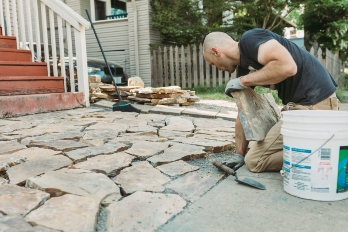This post is part of our ongoing series on home heating systems and costs.
Benjamin Franklin famously said that only two things are certain in life, one of which is taxes.
Well, Ben, feel free to add utility bills to that list.
Utilities are a major part of our monthly budgets. For those of us in colder climates, heat makes up at least 40% of our annual utility costs, which means that lowering that expense could have a major impact on our household finances.
While adjusting your property and income taxes can be a rather complicated process, here are six easy ways to reduce your heating bills:
1. Program your thermostat
This may sound a little obvious, but the lower you keep the temperature in your home during the cold months, the less money you’ll need to spend on heat.
Installing a programmable thermostat and scheduling it to drop by 7-10 degrees for eight hours per day can reduce your heating bills by 10%.
The key is to be strategic about the hours you choose to lower the temperature. For example, lower it while you’re at work and/or when you’re sleeping, and bring it up when you’re home and awake. Bundle up in a warm sweater and thick socks and give it a try!
Heads up: If the batteries in your thermostat die or your home loses power, you may need to reprogram it.
2. Bulk up your insulation
You may want to brew a hot cup of tea for this statistic: More than 60% of the heat you lose is through your attic.
The problem is that insulation settles over time, so you’ll want to periodically make sure it’s 10-14 inches thick and that any gaps are filled. This is especially important in your attic since it is so prone to heat loss.
Down in your basement, the ceiling should also be insulated. If you notice areas with sagging or missing insulation, fix them. If you don’t see any insulation down there, you may want to consider installing some.
Finally, check your exposed pipes and heat ducts to make sure they have foam insulation, which protects them from freezing.
3. Air-seal your basement and attic
Use caulk or spray foam insulation to fill cracks, gaps, or openings in your foundation, walls, ceilings, and roof. Seal the spaces around your rim joists, which are the vertical pieces of wood on top of your foundation. (Here’s what rim joists look like.) Fill the holes that allow wires, ducts, or pipes to pass through the basement ceiling or attic floor.
Pro tip: You can buy a thermal heat detector at your local hardware store for about $40. It’ll help you see where drafts are getting through so you can air-seal your home more efficiently.
4. Weatherize your windows and doors
Your windows and doors are weak points for your heat, too.
To seal up your windows and doors, use caulk to fill gaps or cracks around the frames. If your windows have storm windows, close them for winter. If not, you can install plastic shrink wrap or bubble wrap over them for an additional layer of insulation.
For your doors, use foam weather stripping and door sweeps. Inspect your weather stripping in the fall and spring and replace as needed. It typically needs to be replaced every few years.
5. Tune up your heating equipment
Similar to how an oil change helps your car get better gas milage, a heating system tune-up significantly increases its efficiency.
Changing the filters is the simplest and most impactful DIY maintenance you can do.
With furnaces, the filters are usually hidden behind a panel near the blower fan. Change them monthly during heating season. If you have a system that runs on heating fuel, there’s also a filter in the burner that needs to be swapped out annually.
Schedule a professional HVAC service the start of each heating season. An annual professional service will lower your heating bills and extend the life of your equipment. Another bonus: It also prevents fires and carbon monoxide risks.
6. Consult a professional
If the techniques included in this post don’t significantly decrease your energy spending, consider hiring a professional for an energy assessment. This typically costs a few hundred bucks, but an expert can further identify specific problem areas and offer detailed solutions. The savings in your utility bills will likely pay off the cost of the assessment pretty quickly.
Some state and local governments offer financial assistance for energy assessments. Research home energy audit programs in your area.
Here’s to a cozy (and cost-effective) winter!
For more preparation tips for the cold weather, check out these posts:
- How should you prepare your home for winter? First, stock up on candles and wine.
- The timeline for completed projects and other key things to hammer out with your contractor.




